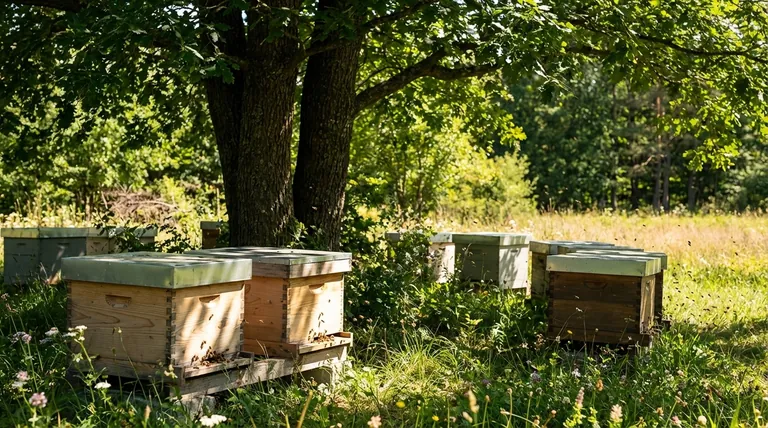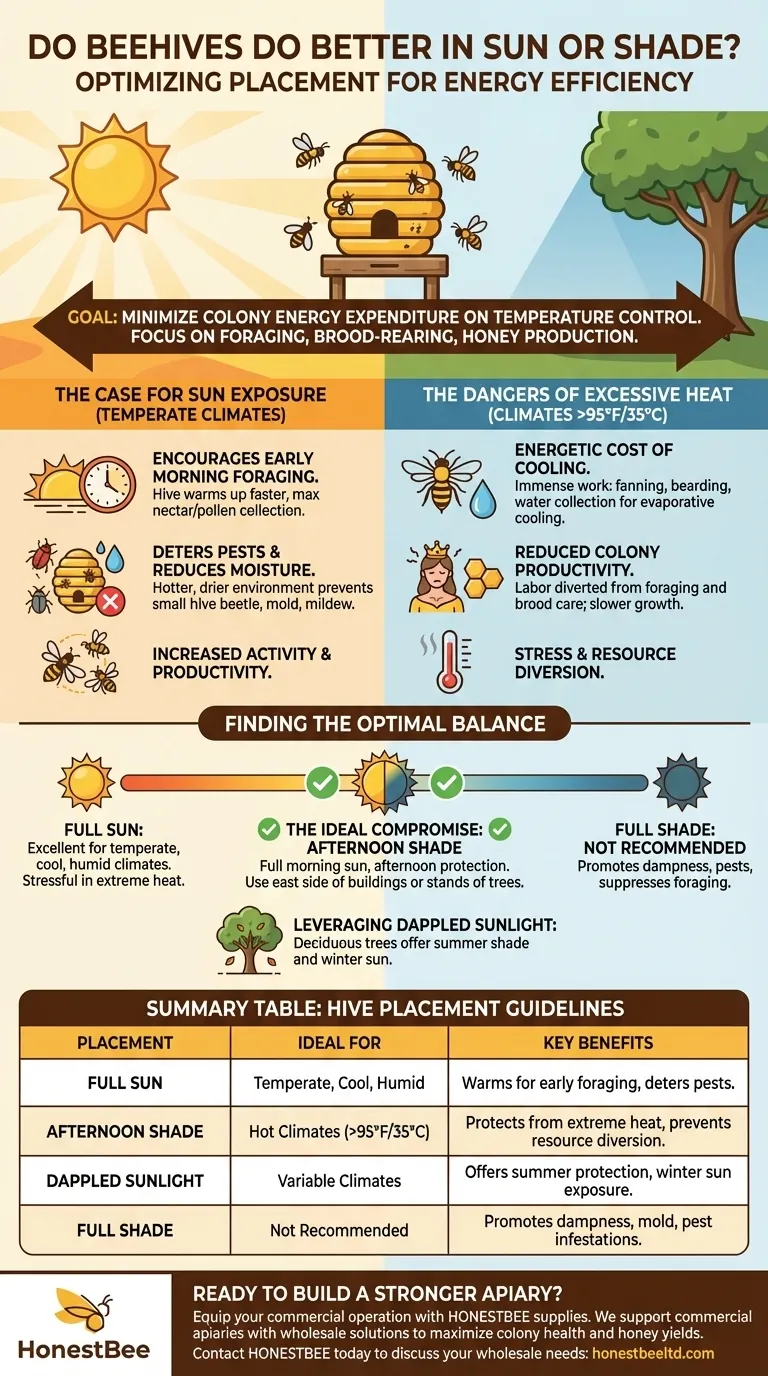For beekeepers, the ideal placement for a beehive is almost always in the sun. This positioning helps the colony manage moisture, deter pests, and encourages earlier foraging. The primary exception is for hives located in climates where temperatures consistently exceed 95-100°F (35-38°C), in which case providing shade during the hot afternoon hours becomes critical.
The question is not simply "sun versus shade," but rather "how can I use hive placement to minimize the energy my colony expends on temperature control?" Your goal is to find the location that allows the bees to focus their efforts on foraging, brood-rearing, and honey production.

The Case for Sun Exposure
Placing a hive in direct sunlight provides several distinct advantages that contribute to a stronger, more productive colony.
Encourages Early Morning Foraging
A hive that catches the first rays of morning sun warms up faster. This allows forager bees to become active and leave the hive earlier in the day, maximizing their time to collect nectar and pollen.
Deters Pests and Reduces Moisture
Many common beehive pests, particularly the small hive beetle, thrive in cool, shady, and damp conditions. Full sun exposure creates a hotter, drier internal environment that is less hospitable to these invaders and also helps prevent the growth of mold and mildew.
The Dangers of Excessive Heat
While beneficial in moderation, relentless sun in a hot climate can impose significant stress on a colony, forcing it to divert resources away from productive tasks.
The Energetic Cost of Cooling
Bees must maintain the internal hive temperature, especially the brood nest, within a narrow range. In extreme heat, this requires an immense amount of work, including fanning at the entrance, "bearding" on the outside of the hive, and collecting water to spread for evaporative cooling.
Reduced Colony Productivity
Every bee tasked with cooling the hive is a bee that is not foraging for nectar, tending to the queen, or caring for larvae. This diversion of labor can lead to a noticeable decrease in honey production and slower colony growth.
Understanding the Trade-offs: Finding the Optimal Balance
The ideal hive location is rarely one of extremes. It's about providing what the colony needs at the right time of day based on your specific climate.
Full Sun vs. Full Shade
A hive in full, all-day sun is excellent for temperate climates but can be dangerously stressful in hot ones. A hive in full, all-day shade is almost never recommended, as it promotes dampness and pest infestations while suppressing foraging activity.
The Ideal Compromise: Afternoon Shade
The most effective strategy for most climates is to position the hive to receive full morning sun but benefit from shade in the afternoon. This can be achieved by placing the hive on the east side of a building or a stand of trees.
Leveraging Dappled Sunlight
Placing a hive under a deciduous tree offers another excellent solution. It provides dappled sunlight and protection during the hottest summer months, then allows for more direct sun exposure after the leaves fall in autumn and winter.
Making the Right Choice for Your Climate
Ultimately, your local environment is the deciding factor. Use these guidelines to position your hive for maximum health and productivity.
- If your primary climate has hot summers (frequently >95°F / 35°C): Prioritize providing shade from the intense afternoon sun.
- If your primary climate is temperate, cool, or has high humidity: Prioritize full sun exposure to keep the hive warm, dry, and active.
- If you are in a variable climate: Aim for the optimal balance of full morning sun and dappled or direct afternoon shade.
Strategic hive placement is one of the most impactful, low-effort decisions you can make to ensure your colony thrives.
Summary Table:
| Placement | Ideal For | Key Benefits |
|---|---|---|
| Full Sun | Temperate, cool, or humid climates | Warms hive for early foraging, deters pests, reduces moisture |
| Afternoon Shade | Hot climates (>95°F / 35°C) | Protects from extreme heat stress, prevents resource diversion |
| Dappled Sunlight | Variable climates | Offers protection in summer, more sun exposure in winter |
| Full Shade | Not Recommended | Promotes dampness, mold, and pest infestations |
Ready to build a stronger, more productive apiary?
The right hive placement is just the start. Equip your commercial operation with durable, high-performance beekeeping supplies from HONESTBEE. We support commercial apiaries and distributors with wholesale-focused operations, providing the equipment you need to maximize colony health and honey yields.
Contact HONESTBEE today to discuss your wholesale needs and discover how our supplies can help your business thrive.
Visual Guide

Related Products
- Langstroth Bee Hives Bee Keeping Box for Beginners Beekeeping
- Australian Langstroth Beehive Boxes for Beekeeping Wholesales
- HONESTBEE Advanced Ergonomic Stainless Steel Hive Tool for Beekeeping
- HONESTBEE Professional Long Handled Hive Tool with Precision Cutting Blade
- Professional Dual-End Stainless Steel Hive Tool for Beekeeping
People Also Ask
- Why are Langstroth hives recommended for beginners? Unmatched Support & Standardization
- Why might a beginner be advised to start with a Langstroth hive? Unlock a Supportive Beekeeping Ecosystem
- What are the key features of the Langstroth beehive? A Guide to the Standard for Modern Beekeeping
- How does the orientation of the hive sides benefit comb construction? Ensure Straight, Movable Combs for Easier Hive Management
- Should a beginner try a different type of hive? Start with a Langstroth for a solid foundation.



















